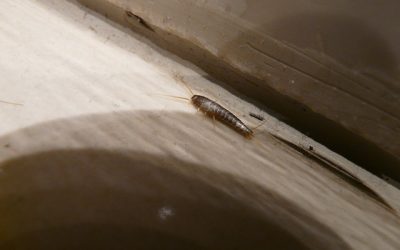Silverfish

Silverfish are wingless, flattened, fish-shaped insects, usually not more than ½ inch long. They have long antennae and three threadlike appendages at the end of the abdomen. They have chewing mouthparts and develop without metamorphosis.
Silverfish usually enter a structure through insulation during construction. They eat a wide variety of foods containing starches and carbohydrates such as rolled oats, dried beef, flour, starch, paper, cotton, some synthetic fibers, sugar, beef extract, dead insects, glue, paste and linen. They can also feed on surface molds in damp areas. They can live long periods of time without food. Eggs are laid in protected areas, such as behind baseboards, and hatch in from 20 to 40 days depending on temperature and humidity.
Silverfish prefer temperatures of 70 to 80˚F, moist situations and can be found most anywhere in a house. They are commonly found in attics especially if there are boxes of books.
They can do considerable damage to some natural and synthetic fibers, books, and other paper products. Their feeding marks are irregular and surface etching often appears that may not even penetrate paper. They may also leave yellow stains, especially on linens.
Silverfish are unable to reproduce or even to survive in buildings where winter heating and moisture loss results in low relative humidity. Airtight houses with efficient humidifiers that keep the relative humidity above 50% year-round can develop silverfish infestations that are very difficult to control using typical insecticide applications. To achieve control under those conditions, the relative humidity will need to be reduced. Besides cleanup of clutter and other food items that may be supporting the infestation, insecticide applications are required for silverfish management.
